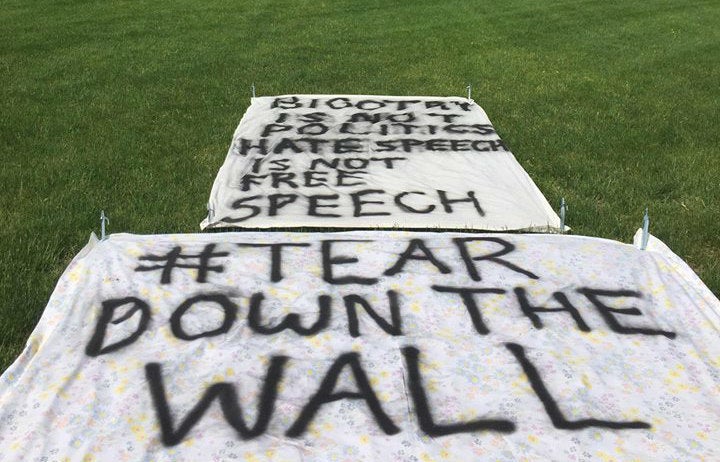
In a school-wide meeting last semester, the head of my boarding high school evoked an ongoing national dialogue surrounding politics, political correctness and free speech. Identifying a campus culture in which students with conservative views felt as though their beliefs were being dismissed, he stressed that both liberal and conservative perspectives should openly and equally thrive. Such a platform would allow us to “lean into our diversity and make it a strength.”
I do believe that conservative opinions warrant engagement on an institutional level. But when an institution appeals to the kaleidoscopic perspective that all beliefs should be welcome and respected, it can fail to deconstruct the identity politics at play beneath a “political viewpoint.” When the meeting adjourned, this call for diversity ascended to the top of the school’s agenda. But I left the 1,200-seat chapel the same way I entered ― disappointed, because the school had failed to explicitly address a deeply disturbing incident.
Weeks earlier, the local police department was in pursuit of Jose Rivera DeJesus, a Latino man with five outstanding warrants for his arrest. The evening chase led him to our campus, where authorities suspected him to be hiding. My school immediately sent out a mass email instructing us to shelter in our dorms. Some students chose to directly ignore this email in favor of a different response.
A group of white male athletes had gone looking for him wielding tennis rackets. Documenting themselves on their Snapchat stories, they branded their posts with the hashtag, #BuildAWall. When I opened my Instagram feed, I discovered that these same boys had a running joke among themselves: Every polo shirt they wore signified another Mexican immigrant thrown back over the wall.

When I confronted these students, some of whom I shared a dorm with, they defended themselves by claiming it’s their “political belief,” and that I was being too politically correct. This claim of a political belief seemed to function as a shield. If so, then there must have been something that the shield was meant to protect, to obscure. I wanted to address why their beliefs could be construed as racist. But I was led into a conversation about partisan politics, and it made me believe that I had to deconstruct every cog of their political machinery through a particularly restrictive lens ― conservative or liberal, Republican or Democrat ― before I could even whisper “race.”
I do not believe these conversations are mutually exclusive. Identity politics examine how people identify with race, gender, socioeconomic class, etc., and how this identification plays a role in politics. Thus, it is a part of politics. And yet, identity has been conflated into an ambiguous definition of “politics”: one that seems to exclude the very facets that define it.
Let me be clear: I am not writing in hopes of beginning a conversation that ends with the castigation of these individuals. How the school addressed these students in private was not publicized, though the school’s stance on “diversity” was certainly clear ― one that eclipses racist and exclusionary views under the rhetoric of political diversity. Therefore, I hope to instead illustrate that a broader cultural problem has bred an institutional quandary, and that those who hold the pen have yet to inscribe cogent markings.
“Every polo shirt they wore signified another Mexican immigrant thrown back over the wall.”
These students are not outliers. Even if an institution writes off their beliefs as a minority within the narrow context of their own school, such beliefs are irrefutably centralized by the wider scope of current American political discourse. Their beliefs articulate those of the Republican presidential nominee, who has garnered a large following using the same, disguised racist rhetoric. In the national spotlight, Trump is often denounced. But within educational institutions, his views are suddenly excused by calls for political diversity. As harmful national and individual interests converge, the educational institution caught in between these forces cannot draw them together while ignoring that, it, too, is a cog in the machine.
Political diversity is valuable. But a definition of political diversity that does not emphasize the reality of identity politics is amorphous, and overlooks how these discussions are often the first issues to be unwelcome and disrespected in the political arena. What then forms is a guise under which racist views must be tolerated. And when such a tolerance is made explicit by an educational institution, that institution becomes an enabler of racist rhetoric.
From a theoretical standpoint, students would surely have their horizons widened in an environment that doesn’t coddle them with “politically correct” terminology. But the intersecting conversations about race, gender and class inequity, among other critical conversations, continue to gather dust under a Trump 2016 sticker. In other words, it becomes almost impossible to move beyond a partisan realm of discourse when traditional politics have been selected by institutions as the starting and ending point of debate.
This concerning pattern of events and responses, or lack thereof, is not limited to a prestigious New England preparatory education or Ivy-draped campuses. Rather, it affects all institutions that sermonize a diversity of political opinions without examining the overlooked conversations beneath such a sweeping claim. To do so is to take a particular political position. It is to beckon for a bipartisan kumbaya, as if ignoring the salience of identity politics in political discourse is an apolitical omission. But there is a reason why an undocumented immigrant, for example, would most likely oppose the building of a wall. Their body is marked by the politics that can destroy it. As such, this sermon is a vacuous enterprise that misleads us from examining structural racism and its manifestation within the educational institution. And when we, whether as educators or students, stand by the guise of this political belief, we too obscure the conversation we have missed all this time.
Recent events, both at my school and throughout the country, can provide a lens through which we can work towards solutions to the problem. A critical step is to have institutions explicitly acknowledge the suppressed conversations of identity that run so deep in many lives, and to present these conversations as a starting point that can and must be supplemented with additional institutional resources.
Indian removal, slavery, Jim Crow, separate but equal: our rocky path to diversity has been laden with the bodies of the oppressed. Thus, we must begin by understanding how each cog turns, and the ones to which they are connected, before the machine itself can be constructed anew. With a billion-dollar endowment and alumni that include former presidents, the school occupies a position of power wealth, and intellectual influence that makes it implicated within systems of power. In its agenda, an institution must first acknowledge the intersection between identity politics and partisan politics before it can affect deeply those who claim to be expressing only their political beliefs.
“Our rocky path to diversity has been laden with the bodies of the oppressed.”
Such tangible steps offer a more effective praxis than an institution’s unsubstantiated claim towards promoting diversity and equity. My school has certainly taken action, enough to warrant some credit: We discuss identity politics in some English and history classes, hold student-led forums, and boast a senior-led curriculum for sophomores on personal and community relationships to identity. Yet, many of these initiatives are optional, and it becomes clear who has opted out.
The school meeting did not stop #BuildAWall from trending on campus. Instead, a palliative medication has been prescribed. It confines the voices of student activists to respectful discourse, while the students vocalizing hateful rhetoric have the integrity of their beliefs affirmed by the same standards. The argument for the right to free speech on campuses has certainly been invoked. But in this space, voices historically privileged by clarion calls for political diversity can enter and leave while others do not have that freedom. It is a trying on of what diversity means, in which particular students can test their racist remarks upon others.
Diversity necessitates the highest standard of meaningful engagement. An institution cannot truly champion this quality unless it can set a framework in which it explicitly acknowledges the institutional elephant in the room before taming it with myriad resources. Though students on campuses across the country thus far have spearheaded conversations, protests and movements, they should not do it alone. Activism that is exercised only by an educational institution’s student body can be exhausting. If institutions fail to amend their stance on what it means to have a diversity of opinions on campus, they unfairly place the onus upon the students themselves ― those who could very well find themselves on the other side of the racket, the wall.
So instead of seeing this shift towards institutional self-awareness as an appeal towards political closed-mindedness, let us see it as the opposite: We have the great opportunity to revisit the systems of power that have been upheld throughout the history of this country and ingrained into the very schools that tell us to challenge them.

